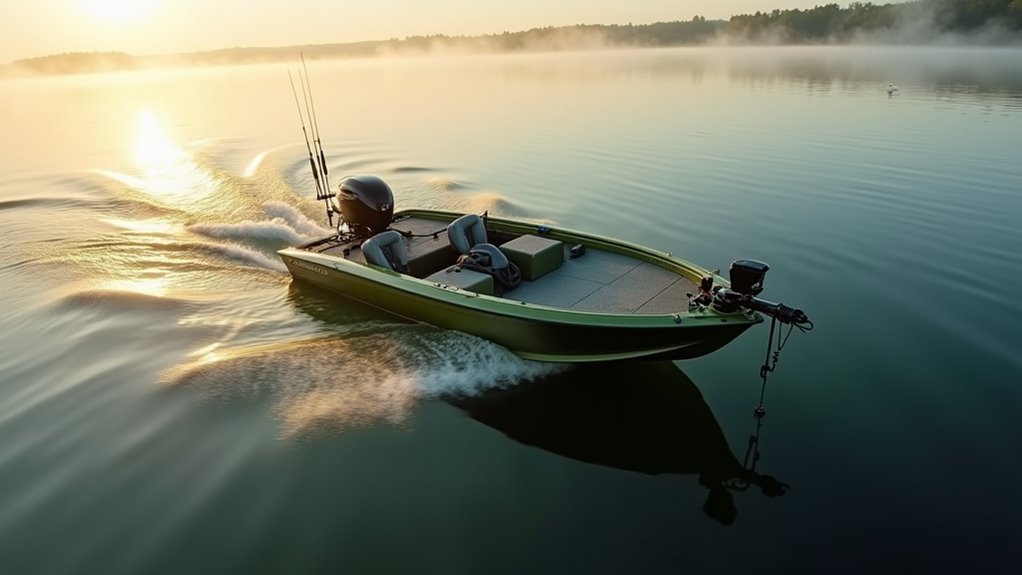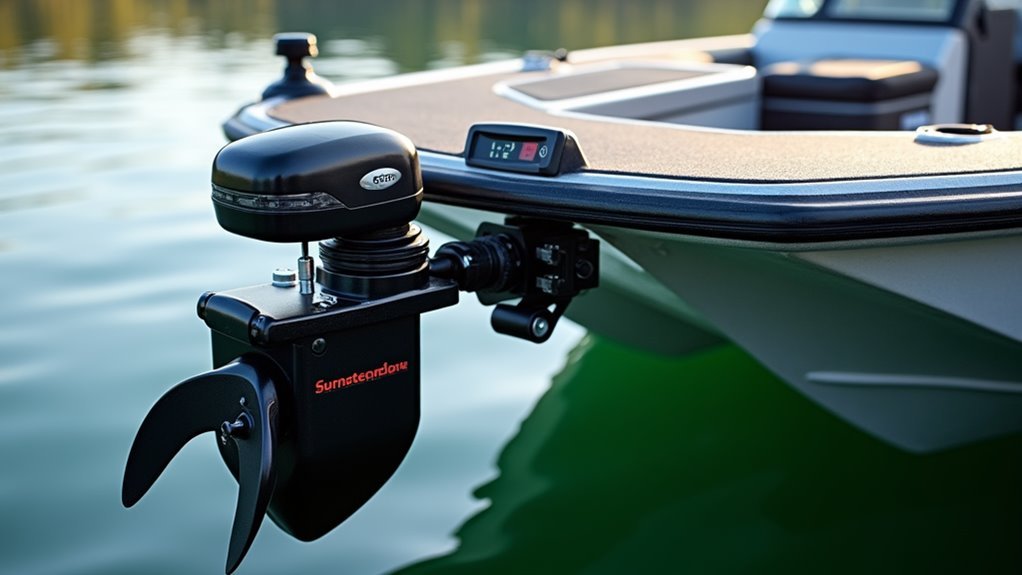Just as a carpenter wouldn't use a sledgehammer to hang a picture frame, we shouldn't overpower or underpower our bass boats with incorrect trolling motor thrust. We've seen countless anglers struggle with motors that either drain their batteries too quickly or fail to maintain position in challenging conditions. The key to peak performance lies in understanding the precise relationship between boat weight, environmental factors, and thrust requirements. Let's explore how to calculate the perfect thrust-to-weight ratio and discover why getting it right can make the difference between a frustrating day and a successful fishing expedition.
Basic Thrust Requirements For Bass Boats
When selecting a trolling motor for your bass boat, understanding the basic thrust requirements is essential for peak performance.
We've found that you'll need at least 2 lbs of thrust for every 100 lbs of boat weight to get the power you're looking for. Since most bass boats weigh between 700 and 1,500 lbs, we recommend looking for motors that deliver 70-80 lbs of thrust.
Don't forget to factor in those challenging days on the water! If you're dealing with wind or current, it's smart to add an extra 10 lbs of thrust to your minimum requirement.
For most bass boats, we've seen great results with 24v trolling motors that provide between 55-90 lbs of thrust. This range gives you plenty of power while maintaining efficient battery use.
Weight Calculation And Thrust Power
To determine the right thrust power for your bass boat, you'll need to start with an accurate total weight calculation. Let's look at how to match your boat's weight with the perfect trolling motor thrust.
For every 100 pounds of your boat's weight, you'll want a minimum thrust of 2 pounds. We recommend adding extra thrust for challenging conditions. Here's a quick guide:
| Boat Weight | Minimum Thrust | Recommended Thrust |
|---|---|---|
| 1000 lbs | 20 lbs | 30 lbs |
| 1500 lbs | 30 lbs | 40 lbs |
| 2000 lbs | 40 lbs | 50 lbs |
| 2500 lbs | 50 lbs | 60 lbs |
Remember to include your gear, fuel, and passengers when calculating total weight. This guarantees you'll have enough power to maneuver freely in any conditions.
Environmental Impact On Power Needs

Environmental conditions play a major role in determining your trolling motor's actual power needs. When we're out on the water, factors like wind and current can dramatically increase the thrust level required to maintain control.
We've found that adding at least 10 pounds of thrust to your baseline calculation helps compensate for windy situations.
For bass boats around 2,000 pounds, while a 40-pound thrust motor might work on calm days, we'll need up to 80 pounds of thrust when conditions get rough.
The way your hull's designed matters too – deep V-hulls typically need more power to push through choppy waters than flat-bottom boats.
That's why we always recommend sizing up your trolling motor to handle those challenging days when environmental conditions aren't in your favor.
Battery Systems And Thrust Levels
Understanding battery systems is vital for matching the right thrust levels to your boat's needs.
When we're purchasing a trolling motor, we'll want to take into account that our fully loaded boat requires 2 pounds of thrust for every 100 pounds of weight. For most bass boats, 24v systems delivering 55-90 pounds of thrust work well in moderate conditions, while 36v systems offering over 80 pounds of thrust handle tougher situations.
We'll need a dedicated battery for every 12 volts, so a 24v system requires two batteries.
Let's not forget about amp hours – they're important for staying out longer on the water. A 100 amp hour rating will keep us fishing twice as long as a 50 amp hour battery, giving us the freedom to explore more fishing spots.
Motor Placement And Performance

Now that we've covered battery requirements, let's focus on motor placement for peak performance. When installing your trolling motor, we'll want to position it toward the bow for the best control and maneuverability. Remember, your motor's thrust should match your boat weight – you'll need at least 2 pounds of thrust for every 100 pounds of boat.
| Feature | Impact on Performance |
|---|---|
| Shaft Length | 12" below waterline minimum |
| Position | Forward mount for control |
| Thrust Power | 2 lbs per 100 lbs weight |
For ideal performance, we'll want to avoid placing the motor too far back, as this can reduce efficiency, especially in rough water. Many bass boats now come with advanced control features like i-Pilot, which can greatly improve your navigation precision and overall performance on the water.
Common Bass Boat Thrust Charts
When selecting a trolling motor for your bass boat, proper thrust calculations guarantee peak performance on the water. For most bass boats weighing between 1,800 to 2,500 pounds, we recommend a thrust range of 70 to 112 pounds.
Let's break down the math: you'll need a minimum thrust of 2 pounds per 100 pounds of boat weight. For example, if you've got a 2,000-pound boat, start with 40 pounds of thrust.
We've found that environmental factors play a huge role in performance. In windy conditions, add an extra 10 pounds of thrust to your calculations.
Many anglers choose 24v motors for their reliability across various fishing situations. These motors deliver thrust levels between 55 to 90 pounds, giving you the freedom to navigate confidently while maintaining efficient battery use.
Advanced Features And Power Management

Modern trolling motors have revolutionized bass fishing through advanced GPS features and intelligent power systems. When choosing the right trolling motor, we need to take into account both power management and advanced features like Minn Kota's i-Pilot technology, which helps us stay locked on prime fishing spots.
Battery management is essential for getting the most from our setup. We'll want to match our system's voltage requirements – whether it's 12 volts or higher voltage configurations – to our fishing style.
During trolling motor installation, we can opt for deep cycle lithium batteries that'll give us extended time on the water while keeping our boat lighter. By monitoring amp hours and using onboard chargers, we're ensuring our power system stays ready for those long days chasing bass.
Frequently Asked Questions
How Big of a Boat Will a 55LB Trolling Motor Push?
We can use a 55lb thrust trolling motor to push boats up to 1,375 lbs efficiently, but let's factor in water conditions and our gear weight for maximum motor efficiency and speed.
How Many Lbs of Thrust Do I Need for My Boat?
Quick as lightning, we'll need to calculate thrust power based on your boat weight first. For every 100 pounds, you'll want 2 pounds of thrust, considering water conditions and fishing style.
How Big of a Boat Can a 30 Lb Trolling Motor Push?
We recommend a 30 lb trolling motor for boats under 1,500 lbs, but it's most efficient with vessels around 1,000 lbs or less, especially when you're considering water conditions and gear weight.
What Size Trolling Motor Do I Need for a Bass Boat?
We'll need to match your bass boat's weight – calculate 2 pounds of thrust per 100 pounds. Most boats perform best with 80-110 pounds thrust, using 24V systems for ideal power and efficiency.